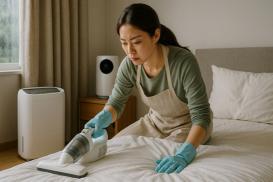Cleanliness blind spots, things you touch every day are dangerous
Sep 16, 2025
|
Items that are frequently used but easy to manage are often a blind spot for hygiene. These things you reach every day, remember when was the last time you wiped them properly? Let's keep healthy and create a refreshing daily life with small habit changes.
1. Smartphone
There is also a story that a smartphone held in hand for nearly 24 hours has more bacteria than a toilet seat. Bacteria reproduce quickly by contacting various environments such as hands, faces, pockets, and bags. Wipe the screen and buttons with alcohol cotton or a dedicated cleaner once a day and clean the case thoroughly. Reducing the use of smartphones before washing hands is also a way to reduce germs.
2. kitchen sponge and dishcloth
It is a multi-purpose dishcloth that wipes sinks, cooks and wipes moisture. However, food waste, moisture and germs are absorbed together in the process, which speeds up reproduction. In particular, if left wet, bacteria and fungi proliferate rapidly. It is hygienic to boil the dishcloth every 1-2 days or microwave it to sterilize it, and replace the sponge with a new one every 2 weeks. It is also a good idea to separate dishcloths and sponges for each purpose.
3. bathroom supplies
a towel that touches a clean body after a shower. However, it is easy to be left wet, and if it is reused several times, it becomes a good environment for fungi and bacteria to inhabit. In particular, it is better to change the face towel every day. Let's dry it in the sun every day and wash it 2-3 times a week. Washing with hot water can effectively remove germs.
Toothbrushes that carry bacteria in the mouth rapidly increase bacterial reproduction if placed near the toilet or left wet. After use, it is recommended to shake off the moisture and dry it completely, and replace it once a month.
4. Bags and wallets
Handbags and wallets touch the floor, chairs, and public transportation handles to accumulate germs. In particular, leather materials are easy to be careless because germs survive for a long time, but contamination is not easily noticeable. Wipe the outside with an alcohol tissue once a week, and thoroughly shake off the inside to remove dust. Cloth bags are washed periodically if washable, and hygiene is improved by maintaining ventilation during drying. Using a waterproof pouch inside the bag is also effective in preventing contamination.
5. reusable water bottle
Bacteria easily accumulate at the entrance and inside of reusable water bottles. Negligent cleaning can lead to mold. Wash it with dishwashing detergent and bottle brush every day, and disinfect it once a week with vinegar. After washing, the lid is opened, completely dried, and then stored to prevent bacterial growth. If the inside of the water bottle is complicated, use a cleaning brush to manage every corner.
6. Earphones and Headphones
Earphones and headphones reproduce bacteria with earwax and skin oil. In particular, the risk of infection is high when shared. Wipe your eartip with alcohol once a week, and replace your headphone pad. It is hygienic if stored in a well-ventilated place after use. Let's keep the inside of the earphone case clean by wiping it with an alcohol tissue.
7. Keyboard and mouse
Keyboard and mouse are the most touched items, and dirt, sebum, and food debris accumulate and bacteria reproduce. In particular, the keyboard gap is easy to become a hotbed for germs. Once a week, remove the gap dust with a compressed air spray, and wipe the surface with an alcohol tissue. The mouse is disinfected around the area that touches the palm, and the mouse pad is also hygienic if washed periodically. Using keyboard covers will help reduce pollution.
I can't rest assured that it looks clean. Rather, the more familiar things are, the more often and meticulously managed to maintain real cleanliness. Sanitary blind spots in your daily life, let's check again from now on and keep our precious health with simple cleaning habits.
This article was translated by Naver AI translator.














